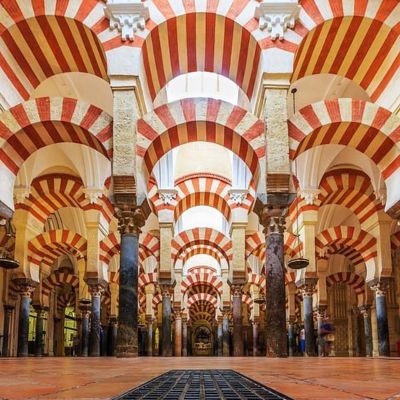Istanbul’s most recognized icon, the Hagia Sophia was commissioned by Emperor Justinian and built in 537 AD by two master builders: Isidore of Miletus and Anthemius of Tralles. Throughout its long and turbulent history, the transformation of Hagia Sophia has suffered fires and earthquakes but has always restored to its former glory.
The History of Hagia Sophia
Originally built as a church for the Byzantine kingdom, the building served as a mosque from 1453 AD through 1931 before it was declared a museum in 1935 when Turkey affirmed its secular agenda. The transformation of Hagia Sophia is evident here in its diverse roles throughout history.
Hagia Sophia is today accessed from an urban plaza that has a string of open cafes on one end and enchanting streets on the other.

Most astonishingly, the Hagia Sophia served as an unopposed architectural beacon for nearly 1,000 years before the Turkish architect, Sinan, built his masterpiece the Selimiye Mosque in 1574 AD in Edirne, Turkey. By comparison, the Taj Mahal as an architectural inspiration is only 360 years old!
Located in the Sultan Ahmet area, access to the Hagia Sophia is through a fairly sized plaza that has a string of open cafes on one end and Istanbul’s enchanting streets on the other.
Inside, the Hagia Sophia gradually builds on you. Leading you to the second floor are large winding ramps, originally used by horses, which also reveal lovely brickwork and arcuate geometry of the structure. This is of course not the intended circulation pattern as planned by its original builders but a recently adopted one to manage large crowds visiting the Hagia Sophia everyday.

The amazing atrium of the Hagia Sophia leaves an indelible impression on memory.
The ramps culminate onto a gallery that looks at an enormous atrium and you are unexpectedly greeted with an explosion of space! You are prompted to look up at either the grand dome or down at the lovely low-hanging chandeliers that accentuate the dome’s geometry. The impression it gave me was of being afloat in enclosed space.
Adorning the vertical planes of the gallery are large medallions with Arabic inscriptions of Allah and the prophet, the first four caliphs and the two grandsons of the prophet. Contrasting to the Muslim ornamentation are the majestic mosaics from the Christian era that are elegantly poised throughout the building.
Istanbul’s Hagia Sophia was made using building materials from various other countries. The natural grain and colour of the stones used is still very sharp and vibrant. Decorative elements such as the frescos and mosaics continue to captivate with their clarity and state of preservation.

The highly ornamental mihrab at the Mosque-Cathedral of Cordoba.
And even if one is considerate of the fact that the Hagia Sophia has been rebuilt and restored in parts over time, it still is extremely intriguing that such an engineering – architectural feat was achieved nearly 1500 years ago and remains a coveted blueprint even today.
The Hagia Sophia’s kindred spirit, the Mosque-Cathedral of Cordoba in Spain too was built over centuries. As though drawing parallels to the Hagia Sophia in its history, it was incepted as a church in 600 AD for the Visigothic kingdom.
With the Ummayads establishing their stronghold in Andalusia over subsequent years, the building was converted into a mosque in 784 AD that only grew bigger until the Ummayads were defeated during the Reconquista in 1236 AD. The new Christian rulers reinstated the building as a Catholic Church, which it remains to present day.

Rays of light coming through the rose window fall a couple of feet short of the mihrab at the Mosque-Cathedral of Cordoba.
Strategically located at the edge of a famous Roman bridge and clearly visible from across the Guadalquivir river, it was perhaps once a visual marker but today, the Mosque-Cathedral of Cordoba is a bit more difficult to find once you’ve entered the old streets of the city.
As you get into the complex, a large courtyard with old citrus trees impresses you. Then, as you proceed towards the building, the sequencing of space begins. And it is magical. Your eyes are just about adjusted to the dark bays of the hypostyle mosque when you are drawn, almost magnetically, to a shaft of light. And once you yield to this vortex-like force, you feel that you are in some other enchanting building altogether. This part is the Catholic Church that resides within the mosque founded by the Ummayads.
Whether the new Christian rulers’ motives to preserve the rest of the mosque were political or emotional, their act to insert a church within the existing structure, with surgical precision and artistic discretion, can be seen as a gesture balancing tolerance and assertion.

Brick and stone bands render the hypostyle hall rhythmic, warm tonal qualities.
But essentially, the experience of walking through the Mosque-Cathedral of Cordoba is like drifting in a dream where a medley of myriad spatial configurations meshes into one resounding whole. The contrasting horizontality of the double arched bays with the verticality of the nave makes the unison seem almost impossible. And yet, the effect is compounded by seamless blending of ornament and structure reinforcing the notion that architecture can succeed in moving the soul.
Just like the Hagia Sophia, the Mosque-Cathedral of Cordoba is an overlay of two cultures and here you find complex geometric patterns with intricate gold gilding and red specks rub shoulders with rays of light filtering through multicoloured rose windows while the organ resonates in the church. The presence of two architectures is harmonious as though of kin. The transformation of Hagia Sophia reflects the blending of Christian and Muslim influences, similar to the Mosque-Cathedral of Cordoba.
Both, the Hagia Sophia and the Mosque-Cathedral of Cordoba, also bear palimpsestic overtures. Their histories of building and rebuilding make for a rich showcase of cultural traditions – Christian and Muslim in one building.
Design, in both cases, mediated in establishing the image of each city. It played a vital part in and continues to testify the high place that architecture enjoys in making a statement about the people of a place and their ambitions for it.
